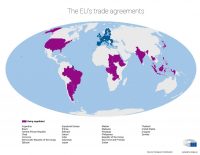 The European Union (EU) revealed that in 2015, it was “the largest global exporter and importer of goods and services”.
The European Union (EU) revealed that in 2015, it was “the largest global exporter and importer of goods and services”.
In a report, the European parliament noted that results showed the EU represented 32.51 percent of “total world trade”, while the USA and China only accounted for 12.01 percent and 10.68 percent respectively. It added that it has been “negotiating trade agreements since the 1970s, then as the European Communities”, and noted that “over time it has diversified its trading partners, and is now negotiating trade agreements with partners from every continent”.
The report added that the “content of trade agreements has also evolved as EU trade competences have developed”, with the EU “currently in the process of amending and modernising some of its older trade agreements” and “working on some of the most ambitious trade agreements since its inception”, including the Comprehensive Economic and Trade Agreement (CETA) with Canada, and the Transatlantic Trade and Investment Partnership (TTIP) with the USA.
The remainder of the report served as a “guide to procedures for the conclusion of international trade agreements”, with the EU noting that “the Lisbon Treaty modified both the EU’s competences in trade and the procedure for concluding trade agreements, giving a stronger role to the European parliament”, and its report studies the conducting and conclusion of trade negotiations as well as the “key issues in the current EU trade policy debate”.
